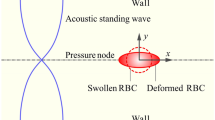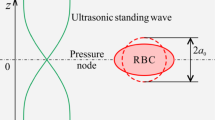Abstract
Based on the proposed higher order gradient quasi-continuum model, the numerical investigations of the basic mechanical properties and deformation behaviors of human red blood cell (RBC) membrane under large deformation at room temperature (i.e., 300 K) are carried out in the present paper. The results show that RBC membrane is a nonlinear hyperelastic material. The mechanical properties of RBC membrane is dominated by isotropic nature at the stage of initial deformation, however, its anisotropic material properties emerge clearly with the loading increasing. The out-of-plane wrinkling of RBC membrane upon shear loading can be reproduced numerically. With the use of the so-called higher order Cauchy–Born rule as the kinematic description, the bending stiffness of RBC membrane can be considered conveniently.















Similar content being viewed by others
References
An XL, Mohandas N (2008) Disorders of red cell membrane. Br J Hematol 141:367–375
Arroyo M, Belytschko T (2002) An atomistic-based finite deformation membrane for single layer crystalline films. J Mech Phys Solids 50:1941–1977
Boey SK, Boal DH, Discher DE (1998) Simulations of the erythrocyte cytoskeleton at large deformation. I. microscopic models. Biophys J 75:1573–1583
Bratosin D, Tissier JP, Lapillonne H, Hermine O, de Villemeur TB, Cotoraci C, Montreuil J, Mignot C (2011) A cytometric study of the red blood cells in Gaucher disease reveals their abnormal shape that may be involved in increased erythrophagocytosis. Cytom B Clin Cytom 80B:28–37
Dao M, Lim CT, Suresh S (2003) Mechanics of the human red blood cell deformed by optical tweezers. J Mech Phys Solids 51:2259–2280
Dao M, Li J, Suresh S (2006) Molecularly based analysis of deformation of spectrin network and human erythrocyte. Mater Sci Eng C 26:1232–1244
Delaunaya J (2004) The hereditary stomatocytoses: genetic disorders of the red cell membrane permeability to monovalent cations. Semin Hematol 41:165–172
Discher DE, Boal DH, Boey SK (1998) Simulations of the erythrocyte cytoskeleton at large deformation. II. micropipette aspiration. Biophys J 75:1584–1597
Dolbow J, Belytschko T (1998) An introduction to programming the meshless Element free Galerkin method. Arch Comput Methods Eng 5:207–241
Fedosov DA, Caswell B, Karniadakis GE (2010) A multiscale red blood cell model with accurate mechanics, rheology, and dynamics. Biophys J 98:2215–2225
Guo X, Wang JB, Zhang HW (2006) Mechanical properties of single-walled carbon nanotubes based on higher order Cauchy–Born rule. Int J Solids Struct 43:1276–1290
Hansen JC, Skalak R, Chien S, Hoger A (1996) An elastic network model based on the structure of the red blood cell membrane skeleton. Biophys J 70:146–166
Hartmann D (2010) A multiscale model for red blood cell mechanics. Biomech Model Mech 9:1–17
Lancaster P, Salkauskas K (1981) Surfaces generated by moving least squares methods. Math Comput 37:141–158
Lenormand G, Hénon S, Richert A, Siméon J, Gallet F (2001) Direct measurement of the area expansion and shear moduli of the human red blood cell membrane skeleton. Biophys J 81:43–56
Liu S, Derick LH, Palek J (1987) Visualization of the hexagonal lattice in the erythrocyte membrane skeleton. J Cell Biol 104:527–536
Marko J, Siggia ED (1995) Stretching DNA. Macromolecules 28:8759–8770
Mills JP, Qie L, Dao M, Lim CT, Suresh S (2004) Nonlinear elastic and viscoelastic deformation of the human red blood cell with optical tweezers. Mech Chem Biosyst 1:169–180
Mukhopadhyay R, Lim GHW, Wortis M (2002) Echinocyte shapes: bending, stretching, and shear determine spicule shape and spacing. Biophys J 82:1756–1772
Sun Y, Liew KM (2008) Application of the higher-order Cauchy–Born rule in mesh-free continuum and multiscale simulation of carbon nanotubes. Int J Numer Methods Eng 75:1238–1258
Wang XY, Guo X (2012) Numerical simulation for finite deformation of single-walled carbon nanotubes at finite temperature using temperature-related higher order Cauchy–Born rule based quasi-continuum model. Comput Mater Sci 55:273–283
Wang XY, Guo X, Su Z (2014) A quasi-continuum model for human erythrocyte membrane based on the higher order Cauchy–Born rule. Comput Methods Appl Mech Eng 268:284–298
Yan JW, Liew KM, He LH (2013) Buckling and post-buckling of single-wall carbon nanocones upon bending. Compos Struct 106:793–798
Zhang P, Huang Y, Geubelle PH, Klein PA, Hwang KC (2002) The elastic modulus of single-walled carbon nanotubes: a continuum analysis incorporating interatomic potentials. Int J Solids Struct 39:3893–3906
Acknowledgments
The financial support from the Promotive Research Fund for Excellent Young and Middle-aged Scientists of Shandong Province, China (BS2014SF004), the Doctoral Starting up Foundation of Ludong University, China (LY2014022), the National Science Foundation of China (11372281), the province Science Foundation of Zhejiang (Y13A020009), and Natural Science Fund of Shandong Province (ZR2013EEL007) are gratefully acknowledged.
Author information
Authors and Affiliations
Corresponding author
Rights and permissions
About this article
Cite this article
Wang, X.Y., Wang, J.B., Qiu, B.B. et al. Large Deformation Properties of Red Blood Cell Membrane Based on a Higher Order Gradient Quasi-continuum Model. J Membrane Biol 248, 979–990 (2015). https://doi.org/10.1007/s00232-015-9809-6
Received:
Accepted:
Published:
Issue Date:
DOI: https://doi.org/10.1007/s00232-015-9809-6




